Comuni
Author: Acchittocca
Publisher: Huch & Friends / Tenki Games
Year: 2008
review by

| x |
|
|
|
|
|
|
|
|
|
|
|
|
|
|
|
|
|
|
|
|
|
|
|
|
|
|
|
|
|
|
|
|
|
|
|
|
|
|
|
|
|
|
|
|
|
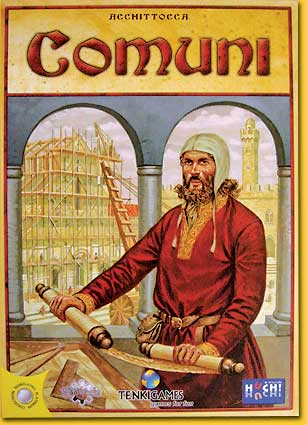 |
|
In the late Middle Ages, the Italian comuni (a sort of city councils) were trying to surpass each other in wealth and status. In addition to this rivalry, the rulers of the comuni also had common enemies that were lurking at the borders of Italy, waiting for a chance to have their share of the wealth. The rulers of Milano, Bologna, Lucca, Firenze and Sienna had no other choice than to bury the hatchet every now and then, and to invest in a common defense mechanism against invading rivals such as Venice or France!
|
| x |
|
|
|
|
|
|
|
|
|
|
|
|
|
|
|
|
|
|
|
|
|
|
|
|
|
|
|
|
|
|
|
|
|
|
|
|
|
|
|
|
|
|
|
|
|
| Dependent on the number of players, in four to seven columns cards are displayed in rows of 1, 2 or 3 cards. These cards are drawn from four decks that are worked from A through D. |
| x |
|
|
|
|
|
|
|
|
|
|
|
|
|
|
|
|
|
|
|
|
|
|
|
|
|
|
|
|
|
|
|
|
|
|
|
|
|
|
|
|
|
|
|
|
|
 |
| x |
|
|
|
|
|
|
|
|
|
|
|
|
|
|
|
|
|
|
|
|
|
|
|
|
|
|
|
|
|
|
|
|
|
|
|
|
|
|
|
|
|
|
|
|
|
|
The cards can be used by the players to erect buildings in one of four categories: economic (yellow), military (black), cultural (white) or religious (brown). In addition, each player has four cards that symbolise the building sites for each of the four types of buildings. When a player adds a card to one of his buildings, the coloured side of the corresponding card is placed face-up. This means that the building is active. Active buildings yield income in the income phase, in the shape of cubes of the corresponding colour. After receiving income from a building, the building site card is turned over to its black-and-white side, and the building is inactive. Only after adding an additional card (level) to this building, it becomes active again.
|
| x |
|
|
|
|
|
|
|
|
|
|
|
|
|
|
|
|
|
|
|
|
|
|
|
|
|
|
|
|
|
|
|
|
|
|
|
|
|
|
|
|
|
|
|
|
|
|
The active player first has to choose one out of three options:
a. he may bid on one of the columns of cards, by placing his pawn above this column. If desired, he may add some gold (yellow cubes). It is also allowed to place a pawn in a column already containing another player's pawn, as long as he bids more gold than the previous player. This player may either take back his gold and pawn, or he may move his pawn to another column, at the cost of one pilgrim (brown cube).
|
|
 |
| x |
|
|
|
|
|
|
|
|
|
|
|
|
|
|
|
|
|
|
|
|
|
|
|
|
|
|
|
|
|
|
|
|
|
|
|
|
|
|
|
|
|
|
|
|
|
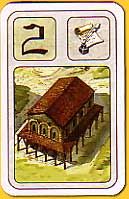 |
x |
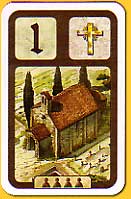 |
|
|
b. if he had placed one or more pawns on the board in previous turns, he may take back all these pawns, and collect all the cards in the corresponding columns.
c. he can collect income from all his active buildings: one white cube for a level one white building, three black cubes for a level three black building et cetera. In addition, each city has a standard income, which is depicted on the player's screen. |
| x |
|
|
|
|
|
|
|
|
|
|
|
|
|
|
|
|
|
|
|
|
|
|
|
|
|
|
|
|
|
|
|
|
|
|
|
|
|
|
|
|
|
|
|
|
|
|
After that, the active player may erect or improve buildings. Each turn, he may build one level of a building, and one level of a defence wall for free. At the cost of craftsmen (white cubes) he may build additional cards. The players collect points for the buildings: one point for a first level, two points for each second level, up to four points for a fourth level. A defence wall can be built using a random card. The card is played face-down: the back of each card depicts a defence wall. Walls do not result in victory points.
|
|
 xx xx |
| x |
|
|
|
|
|
|
|
|
|
|
|
|
|
|
|
|
|
|
|
|
|
|
|
|
|
|
|
|
|
|
|
|
|
|
|
|
|
|
|
|
|
|
|
|
|
 |
|
If one of the decks (A-D) is finished, an invasion takes place. The remaining number of cards in a deck is marked on a seperate track.
|
| x |
|
|
|
|
|
|
|
|
|
|
|
|
|
|
|
|
|
|
|
|
|
|
|
|
|
|
|
|
|
|
|
|
|
|
|
|
|
|
|
|
|
|
|
|
|
| The invasions are the main element of the game. The strength of the invaders increases during the game, so the players should increase their defence as well! Furthermore, the enemy is more interested in prosperous cities than in withering villages, so whoever is leading on the scoring track will be hit much harder than the player who is lagging behind. Each enemy has a standard strength value - the first invasion after deck A is depleted has a strength of 4, the second 8, the third 12, and the fourth 16 - and the players have to add to this value the number of points that they are ahead of the player in the last position on the scoring track. |
| x |
|
|
|
|
|
|
|
|
|
|
|
|
|
|
|
|
|
|
|
|
|
|
|
|
|
|
|
|
|
|
|
|
|
|
|
|
|
|
|
|
|
|
|
|
|
 |
|
Players defend with armies (black cubes); each army has a defence value of one. Armies can be used for the common defence, or to defend your own city. Players reveal simultaneously how many armies they invest in the common defence, and how many armies they send to their own city. The total number of armies invested in the common defence is subtracted from the attacking strength of the invader; this benefits all players.
Armies dedicated to the cities only defend that particular city. These armies can be placed on the defence walls, and their strength increases to 1 + the level of the wall. An army on a third level wall therefore scores 1+3 =4 defence points. This way, all players have to match the strength of the invading army; failure to do so will result in penalty points! The two players that made the highest contribution to the common defence receive a heroism counter as reward; this counter scores victory points at the end of the game. The player that is leading on the scoring track after the fourth invasion wins the game. |
| x |
|
|
|
|
|
|
|
|
|
|
|
|
|
|
|
|
|
|
|
|
|
|
|
|
|
|
|
|
|
|
|
|
|
|
|
|
|
|
|
|
|
|
|
|
|
| x |
|
|
|
|
|
|
|
|
|
|
|
|
|
|
|
|
|
|
|
|
|
|
|
|
|
|
|
|
|
|
|
|
|
|
|
|
|
|
|
|
|
|
|
|
|
| x |
|
|
|
|
|
|
|
|
|
|
|
|
|
|
|
|
|
|
|
|
|
|
|
|
|
|
|
|
|
|
|
|
|
|
|
|
|
|
|
|
|
|
|
|
|
 |
|
|
|
|
|
|
|
|
|
|
|
|
|
|
|
|
|
|
|
|
|
|
|
|
|
|
|
|
|
|
|
|
|
|
|
|
|
|
|
|
|
|
Before you can even think about playing Comuni, you'll have to get through the really terrible rulebook. Actions that are mentioned on page one are explained only three pages later, and there is no coherence whatsoever. Only after finishing the last paragraph, all components have finally been explained; then you are ready to start reading the rules for the second time, this time actually understanding what they are talking about.
|
|
|
|
|
|
|
| x |
|
|
|
|
|
|
|
|
|
|
|
|
|
|
|
|
|
|
|
|
|
|
|
|
|
|
|
|
|
|
|
|
|
|
|
|
|
|
|
|
|
|
|
|
|
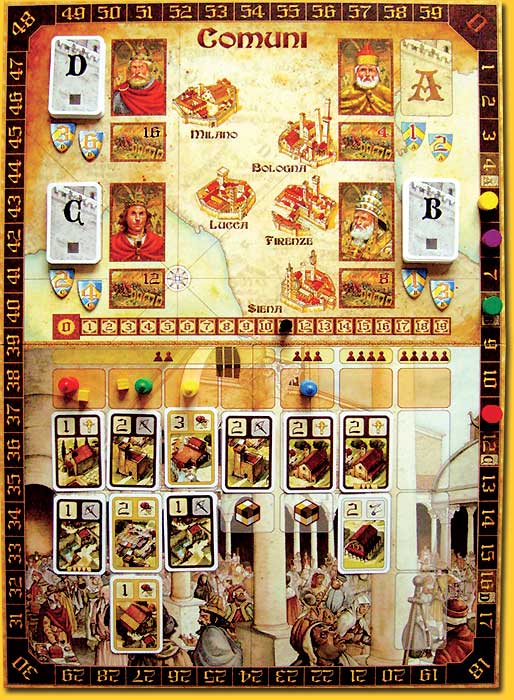 |
| x |
|
|
|
|
|
|
|
|
|
|
|
|
|
|
|
|
|
|
|
|
|
|
|
|
|
|
|
|
|
|
|
|
|
|
|
|
|
|
|
|
|
|
|
|
|
|
And then you find out that Comuni is a really nice game, with many interesting choices to be made. For example, if you start building right away, you'll collect lots of income and you'll have many resources at your disposal. But: many buildings means many points, and players with more points are hit much harder during the invasions. It's not advisable to be too far ahead of your opponents: a game with a built-in hit the leader effect!
|
|
|
|
|
|
|
| x |
|
|
|
|
|
|
|
|
|
|
|
|
|
|
|
|
|
|
|
|
|
|
|
|
|
|
|
|
|
|
|
|
|
|
|
|
|
|
|
|
|
|
|
|
|
| Another nice element is that players are in control of when the invasions take place. If the deck is almost empty, but you don't have enough armies to defend yourself in case of an invasion, you can postpone it by collecting income instead of drawing cards. On the other hand, if you suspect that your opponents don't have many armies (the cubes are stored behind the players' screens), but you have enough armies yourself, then it can be interesting to provoke an invasion that will not bother you at all, but will result in many casualties amongst you opponents! |
|
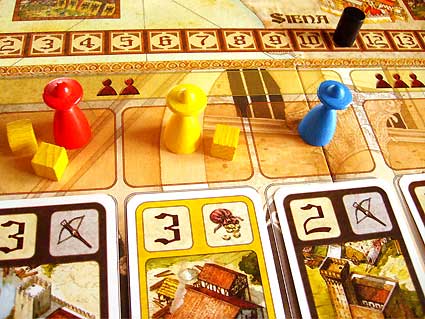 |
| x |
|
|
|
|
|
|
|
|
|
|
|
|
|
|
|
|
|
|
|
|
|
|
|
|
|
|
|
|
|
|
|
|
|
|
|
|
|
|
|
|
|
|
|
|
|
The actions are rather straightforward, so a player's turn doesn't have to take too long. However, when the end of the game comes nearer, it tends to drag a bit because the options to be considered get increasingly complicated. Therefore Comuni is not a short game: approximately two hours. But despite the long playing time, regular players will enjoy sinking their teeth into this interesting strategy game.
© 2009 Barbara van Vugt
Comuni, Acchittocca, Huch & Friends / Tenki Games, 2008 - 2 to 5 players, 12 years and up, 90 minutes
|
  |
|
|
|
|
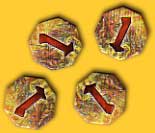 |
|
|
|
|
|
|
|
|
|
|
|
|
|
|
|
|
|
  |
|
|
|
|
|
|
|
|
|
|
|
|
|
|
|
|
|
|
|
|
|
  |
|
|
|
|
|
|
|
|
|
|
|
|
|
|
|
|
|
|
|
|
|
  |
|
|
|
|
|
|
|
|
|
|
|
|
|
|
|
|
|
|
|
|
|
  |
|
|
|
|
|
|
|
|
|
|
|
|
|
|
|
|
|
|
|
|
|
  |
|
|
|
|
|
|
|
|
|
|
|
|
|
|
|
|
|
|
|
|
|
| x |
|
|
|
|
|
|
|
|
|
|
|
|
|
|
|
|
|
|
|
|
|
|
|
|
|
| x |
|
|
|
|
|
|
|
|
|
|
|
|
|
|
|
|
|
|
|
|
|
|
|
|
|
 |
|
|
|
|
|
|
|
|
|
|
|
|
|
|
|
|
|
|
|
|
|
 |
|
|
|
|
|
|
|
|
|
|
|
|
|
|
|
|
|
|
|
|
|
| x |
|
|
|
|
|
|
|
|
|
|
|
|
|
|
|
|
|
|
|
|
|
|
|
|
|
|
|
|
|
|
|
|
|
|
|
|
|
|
|
|
|
|
|
|
|
 |
|
|
|
|
|
|
|
|
|
|
|
|
|
|
|
|
|
|
|
|
|
|
|
|
|
|
 |
|
|
|
|
|
|
|
|
|
|
|
|
|
|
|
|
|
|
|
|
|
|
|
|
|
|
|
|